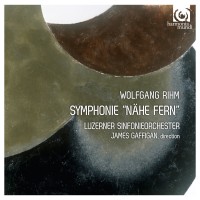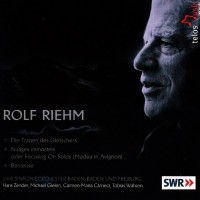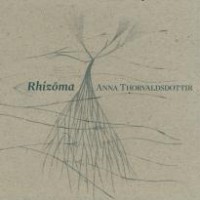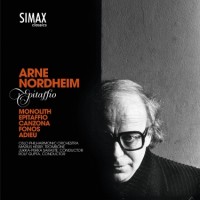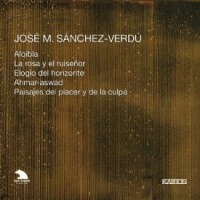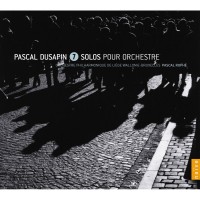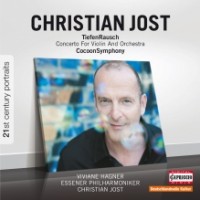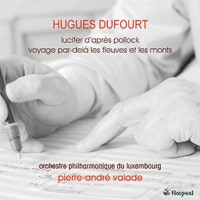Mostly Symphonies 22.
|
Grant Chu Covell [May 2013.] Wolfgang RIHM: Symphonie “Nähe fern” (2012). Hans Christoph Begemann (bar), Luzerner Sinfonieorchester, James Gaffigan (cond.). Harmonia Mundi HMC 902153 (1 CD) (http://www.harmoniamundi.com/). A prolific self-borrower, Rihm may have always had Brahms in mind. Intended as a response to Brahms’ four, this symphony could be the primordial soup from which Hamburg’s greatest son emerged. Rihm claims no quotations even though violins do swoop in with familiar motives and some phrases recoil, leaving Brahmsian chords. In Nähe fern 4 at around 2:10, the string line bops across several of Johannes’ big themes. Rihm’s Ur-Brahms can be gloomy, indeed nightmarish. Goethe’s bitty song, also once set by Rihm’s predecessor, “Dämmrung senkte sich von oben” (“Dusk has fallen from above”), sits between the first and second movements. There’s more to this than a sequence of arcane needle-drops. Rihm’s anachronistic modernism proves engaging. Rolf RIEHM: Die Tränen des Gletschers (1998)1; Nuages immortels oder Focusing On Solos (Medea in Avignon) (2001)2; Berceuse (1984-85)3. SWR Sinfonieorchester Baden-Baden und Freiburg1,2,3, Hans Zender1,2, Michael Gielen3, Carmen-Maria Cârneci3, Tobias Wahren3 (conds.). Telos Music TLS 128 (1 CD) (http://www.telos-music-records.com/). Riehm’s newest two display an earnest exploration of scale and a determined escape from mid-century trends. Of course, a composition for large orchestra needn’t be avant-garde, despite its unrelated panels, widely leaping lines and exotic percussion. Gletschers’ slow brass chorales do suggest the gigantic. An organ cluster presumably sampler-delivered becomes both interruption and subject. Nuages immortels offers a recurring brass motive resembling the NBC chimes. It’s possible to hear the same sectional technique Riehm applies in Gletschers and Nuages in the older, more gleeful Berceuse which pulls in dances quotes and gestures. “Rhízōma.” Anna THORVALDSDOTTIR: Dreaming (2008)1; Hrím (2010)2; Streaming Aryhthmia (2007)3; Hidden (2009)4. Justin DeHart4 (perc), Iceland Symphony Orchestra1, CAPUT Ensemble2,3, Daníel Bjarnason1, Snorri Sigfús Birgisson2,3 (conds.). Innova 810 (1 CD) (http://www.innova.mu/). Don’t let a cardboard digipak fool you: Innova knocks one out of the park with three of Thorvaldsdottir’s orchestral works plus a multi-movement inside-/prepared-piano piece. This deliberate music accrues to create organically inspired textures, perhaps a Lachenmann moment spread to a Feldmanesque scale. In Icelandic, “hrím” signifies the gradual growth of ice crystals, and the music expands and glitters accordingly. Dreaming emerges from the mist. Perhaps it’s the recording’s immediacy that captures delicate percussion shading and individual attacks’ energy and fragility. Arne NORDHEIM: Monolith (1990)1; Epitaffio (1963/1978)2; Canzona (1960)3; Fonos (2003)4; Adieu (1994)5. Marius Hesby4 (trb), Olso Philharmonic Orchestra1,2,3,4,5, Rolf Gupta1,2,3,5, Jukka-Pekka Saraste4 (conds.). Simax PSC 1318 (1 CD) (http://www.simax.no/). Here we have an overflowing serving of assertiveness. The 15-minute Monolith rattles the bric-a-brac with its vigorous dissonance and spirited cacophony. Epitaffio includes electric guitar and taped choral sounds. The 1960 Canzona was groundbreaking for Nordheim, with its brutalist style strange and alarming to a then-sheltered Norwegian audience. Fonos consists of “3 memorables” for trombone and orchestra. Adieu is diminutive work for strings and bells. José M. SÁNCHEZ-VERDÚ: Alqibla (1998)1; La rosa y el ruiseñor (2005)2; Elogio del horizonte (2005-07)3; Ahmar-aswad (2000-01)4; Paisajes del placer y de la culpa (2003)5. Joan-Enric Lluna3 (clar), Claudia Barainsky2 (sop), Gabriel Suovanen2 (bar), Banchetto musicale2, Junge Deutsche Philharmonie1, Orchestre de la Suisse Romande2, Orquesta Nacional de España3, hr-Sinfonieorchester4,5, Lothar Zagrosek1, Marek Janowski2, Miguel Harth-Bedoya3, Pascal Rophé4, Peter Rundel5 (conds.). Kairos 0012782KAI (1 CD) (http://www.kairos-music.com/). Grab this with both hands. Sánchez-Verdú treats us to a spectral blend of Spanish and Arabic textures, and old fused with new (La rosa y el ruiseñor includes soprano, baritone and three viola d’amores). Elogio del horizonte is for clarinet and orchestra. The slow repeating gestures nod toward minimalism or the repeating-phrase patterns Debussy employed in La Mer, among other works, with the music’s willowy gauze revealing a medium density. In Ahmar-aswad, I heard what sound like fragments stolen from Mozart-plus-Turkish moments. Perhaps Sánchez-Verdú’s modus is simpler than one might suppose. Regardless, the results astound. Lucia RONCHETTI: Schiffbruch mit Zuschauer (1997, rev. 1999)1; Pinocchio, una storia parallela (2005)2; Il sonno di Atys (2003-04)3. Barbara Mauer3 (vla), Neue Vocalsolisten Stuttgart2: Daniel Gloger (c-tenor), Martin Nagy (ten), Guillermo Anzorena (bar), Andreas Fischer (bass), Rundfunk-Sinfonieorchester Berlin1, Roland Kluttig1 (cond.), Experimental Studio des SWR3, Reinhold Braig3 (electronics). Stradivarius STR 33772 (1 CD) (http://www.stradivarius.it/). In theory, all music assumes an audience. In these three widely varied works (orchestral, vocal quartet, soloist plus electronics) Ronchetti aims for this condition with exaggerated gestures. “Shipwreck with Spectator” portrays dramatic events over which the listener has no control – and never did. One feels powerless nonetheless. Schiffbruch’s waves could have been set in motion by a giant, and the metaphor that we are watching / hearing something controlled by an unseen force continues into the bubbly four-voice Pinocchio tale. I’ve frequently returned to Atys’ wandering viola as it camouflages references to Lully’s eponymous opera. The notes indicate bits of Maderna’s Aura lingering within Schiffbruch. Pascal DUSAPIN: Seven Solos for Orchestra: Go (1992); Extenso (1993-94); Apex (1995); Clam (1998); Exeo (2002); Reverso (2005-06); Uncut (2008-09). Orchestre Philharmonique de Liège Wallonie Bruxelles, Pascal Rophé (cond.). Naïve MO 782180 (2 CDs) (http://www.naive.fr/). Somewhat like a Concerto for Orchestra, Dusapin’s Solos set virtuosic goals. Imagine an entire philharmonic casting a long, sinewy line that slithers across instruments, lightly shaded with supporting notes, almost no harmony, and definitely no counterpoint. It’s as if there’s missing accompaniment, except that the leading line is taken up by a constantly shifting orchestra. While one hears similarities to Scelsi, Dusapin explores all manner of motivic and organizational techniques, including Pettersson’s Sixteenth with its searching obbligato saxophone. The predominantly Latin titles bear modest explanation: No. 4 isn’t about seafood. “Clam” means secretly or stealthily. No. 7 implies raw or unedited. Christian JOST: TiefenRausch* (1997); CocoonSymphony (2003). Viviane Hagner* (vln), Essener Philharmoniker, Christian Jost (cond.). Capriccio 5118 (1 CD) (http://www.capriccio.at/). Sorry, but the world doesn’t need yet another contemporary violin concerto along the lines of Jost’s TiefenRausch. However, the “Five Movements of a Trip to the Center” are worth investigating because of the embryonic arc and concentrated lines. An earlier recording on Coviello (COV 60716) with the Stuttgarter Philharmoniker under Gabriel Feltz missed the point entirely, handling the work like a spastic Wagner instead of a spectral Sibelius. Jost: CocoonSymphony (2003)
Hugues DUFOURT: Lucifer d’après Pollock (2000); Voyage par-delà les fleuves et les monts (2010). Orchestre Philharmonique du Luxembourg, Pierre-André Valade (cond.). Timpani 1C1195 (1 CD) (http://www.timpani-records.com/). Without the notes, I would have confused one work for the other. Dufourt’s Lucifer after Pollock sounds like Debussy. Who knew all that dripping was really impressionistic at heart. While there’s perhaps a case to be made for Pollock as inspiration of the chaotic or pointillistic, this warmth surprises. At nearly 33 minutes, Dufourt achieves the painter’s scale (the booklet’s inset is laughably small). Journey beyond the rivers and mountains, starting from a 10th-century painting by Fan Kuan, takes a more modern tone. Shimmering chords meld one into the other. I’ve generally taken spectralism to mean taking Schoenberg’s Colors movement from Op. 16 to extremes, leveraging instrumental frequencies to create chords that slide through each other. These are long works, perhaps too deliberate for most. (This is Timpani’s second Dufourt release. I couldn’t fathom either Le Cyprès blanc or Surgir on Timpani 1C1112.)
[More Grant Chu Covell, Mostly Symphonies]
[Previous Article:
A Single Breath: Beethoven’s Last Three Piano Sonatas]
[Next Article:
The IPC Sound Power]
|
